(continued from Part I)1(author’s note: all of this is sourced from my personal memories of trading with Clockwork, his actual PnL statements, as well as me personally interviewing him)
Clockwork found the desk growing increasingly lonely. Seeking fresh camaraderie, he requests a move to the middle of the office to be closer to the top traders. The bonds formed with his closest colleagues during the summer 2011 training class had slowly dissolved with everyone having left the ranks, leaving him as the sole survivor.
All my friends are gone. Even Pete. Kinda depressing.
Life at home wasn’t going so great either. Clockwork had been delicately managing a long-distance relationship with his college sweetheart. Stretching across the miles from California, they had intially managed to find a cozy nook in a Queens cottage during the balmy summers. Despite her unwavering support for his Wall Street Trader ambitions, their paths began to diverge as they both find themselves wanting different futures. While the breakup was amicable, it nonetheless gave Clockwork a profound sense of heartache. He decides to fill the void by adopting a cheerful puppy, whom he affectionately names Milky for her white fur. She is his comfort dog, to take on leisurely walks during times of uncertainty.
The time of uncertainty was now. The early 2014 fervor surrounding Pot Stocks and FNMA had subsided and Clockwork finds his PnL slowly regressing. The OTC scanner, which used to buzz with dozens of tickers at the open, now remains blank throughout the day.

To regain his prior success, Clockwork figures that he must get back to the grind and develop other strategies. And honestly… it feels like shit. He reflects on how fleeting success can be–to get a glimpse of bigger profits as a day trader and then your best market just dies off, leaving you with the meager gains from days you thought were long gone.

Clockwork returns to a feeble life of scrimping and saving, like buying $5 footlongs at Subway for lunch, saving a third for dinner and the last third for tomorrow’s breakfast. It’s represents the familiar unease of financial fragility, unsure of where his next paycheck will come from or if he can uphold his status as CPT.
For the remainder of the year, Clockwork stays consistent but the magnitude of his gains are considerably smaller. 70% of his PnL had been clustered in the first 3 months. He finishes 2014 up $306,000–a career best but still feeling like a let down given the hot start.
Portrait of a Trader in Transition (2014-2017)
Clockwork had dumped all his skill points into scalping and OTC Trading, riding a wave of success until the market died off. Then the metagame changed, rendering his skill set obsolete. Such is the life of a trader. Now it’s back to the drawing board to invest his skill points into other aspects of trading that can bear fruit in the future. Over the years, Clockwork spreads his time and capital across a diverse array of strategies from various sources—engaging with top traders on the floor and at WTG’s main office in Austin and exploring emerging strategies from the online tradersphere.

Playing with Fire: Shorting Low Float Stocks
One of the first strategies that Clockwork and I pivot to, following the decline of the OTC market, is shorting volatile low-float stocks2definition: thinly traded, low volume stocks with a minimal number of shares available for public trading. . While this strategy has gained popularity over time, back in 2014, it remained a highly niche retail strategy, never mentioned at all in mainstream trading literature. All that was out there were low-key interviews and notes from obscure yet elite retail traders3(Gregg Schiabica, Eric Wood, and Mikhail Shadkin to name 3 who highly influenced us) that were able to exploit the same broad trading pattern–identifying a Junk Stock that sharply trades higher over several days, only to plummet back down due to the gravity of mean reversion. Often these Junk Stocks would initially breakout on flimsy reasons but would have the potential to trade exponentially higher in a short squeeze. It’s a precarious strategy that promises guaranteed volatility but requires great discipline and high level execution.
Venturing into low-float trading was initially an odd choice for Clockwork because it represented a dramatic shift from what he originally excelled at. He had a knack for scalping stocks that moved smoothly with tight stop losses, whereas low-float stocks were characterized by their wider spreads and less predictable movements.4(thin means less volume is needed to move the price). They traded erratically, marked by abrupt surges of momentum preceeded by periods of weakness—a pattern that ensnared short sellers and lured in momentum traders aiming to capitalize on their predicament. Initially, both of us approached low-float stocks with a high degree of respect and fear. We steered clear of risky maneuvers, such as attempting to short sell directly into an uptrend i.e. scaling into positions moving against us.5(this is a thing certain short sellers do, either out of desperation or ignorance or because they exist in Q2 of the Pain/Time Matrix) Whenever we found ourselves caught with a poor entry, which happened all the time given we were still dilettantes, we took our lumps and covered for a small loss. We would rely on simple heuristics to give us entry signals–first red daily candle, multiple high-% gaps to fill, intraday price goes below VWAP, lower highs, and so on. There was a fair amount of trial and error.
Let’s breakdown some of the notable low floats the Clockwork traded during this time. Every stock felt like a unique adventure, each one ending with yet another lesson that the market is anything but predictable.
VLTC (Voltari Corp). Nobody knew what the hell VLTC did. As a shell company with zero business operation, their main asset was supposedly a series of deferred tax losses. But the real fascination behind VLTC was the fact that they had famed activist billionaire Carl Icahn as an investor6(it’s rare for a low float junker to have big name investors but Icahn had been an IPO investor when the company had still been operating under the name ‘Motricity’) and in April 2015, he increased his stake to 50% of the company–this news shot VLTC up +200% in a single day and then higher over the next 2 weeks. The stock’s spread and whipsaw had us quite fearful and thus reluctant to get in too early. But by the time it hit $20, the chart was so vertical that we had to try to short it.7(Eventually VLTC would get bought out by an Icahn-affiliated company for 86 cents in 2019. Supposedly the back story behind his April 2015 stake increased was that his son, who sat on the board, convinced him to buy more and given that he’s billionaire, buying a couple mil of VLTC was just tossing pennies for ol’ Carl)
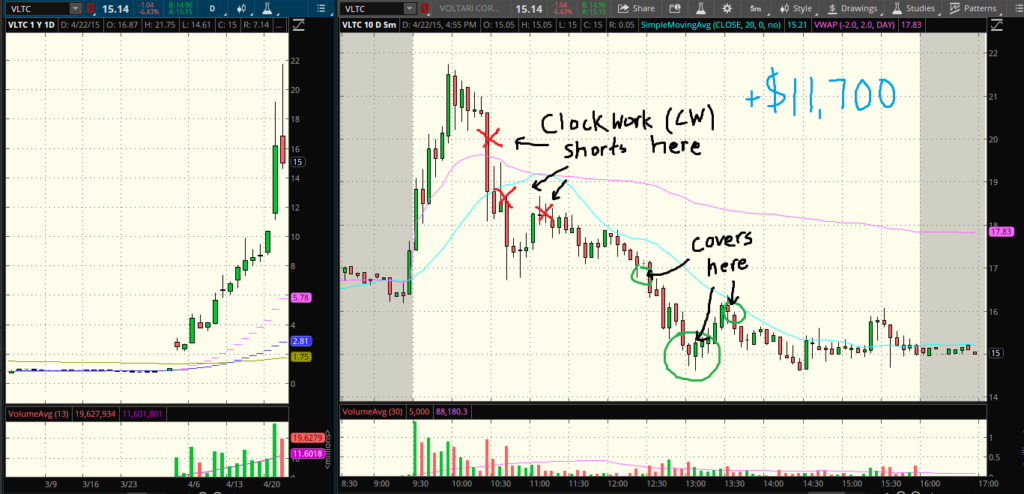
AQXP (Aquinox Pharma) was a small biotech that announced earnings–typically an irrelevant event as small bio’s are expected to burn cash prior to bringing any drugs to market.8(it’s usually clinical data that’s far more important)But don’t try to rely on reason or logic in the realm of low floats. AQXP trades from $2 to $56 in 2 days–the biggest fucking % move we’d ever seen at the time. What actually had been happening was that the Baker Bros9(a biotech-oriented funded ran by two brothers) had bought 40% of the shares outstanding across those 2 days, effectively cornering the float. But parabolic momentum can only last so long and when AQXP broke from the mini-range at $38, Clockwork got short with a $41 stop. The stock eventually closes under $20.

MGT. Good ol’ John McAfee, that crazy ol’ coot. In 2016, McAfee announces that he is to become CEO of MGT Capital and make the company the next great security software play. Price surges higher. The reality? Classic pump and dump with no real product. We knew this piece of shit would crumble hard but we also felt a little too anxious… we would pile in on every initial sign of weakness but the stock kept reclaiming every broken support level. That left us in a hole which increased with every mistimed entry (and we had *many* on this one).
And now I have to explain something that sounds stupid but it works. There’s an artful manuever when trading mean reversion. where when price gets even more ridiculously extreme, you start increasing your bet size even if you’ve taken losses on it10(important note: you’re not adding to an existing losing position, but re-trying a position that’s been stopped out before). Let’s call it Avalanche Scaling11(no deep explanation for this, it just sounds cool). It sounds kind of fucked because it’s a course of action where you are now adding into a position that’s a loser and has been badly mistimed but the logic behind it makes sense: the more extended the price gets, the more powerful the inevitable mean reversion move becomes. Therefore bet more NOW versus prior bets. It’s the dark side of shorting.
On the final day of the MGT pump, the stock drop 50% in mere minutes. By now we’ve built up so much pent-up anger on this stock, we avalanche scale against our prior losses on MGT and move ‘all-in’. This piece of shit MGT can die. Give us our money back and then more for the effort!

KBIO. KaleBio was an insolvent biotech with seemingly nowhere to go other than bankruptcy. It traded pretty close to 0, going as low as 40 cents… and then without any news, volume came in and KBIO ramped up to $2.50 in 2 days. Short sellers attributed this unexpected rise to retail speculation, convinced it presented a slam dunk short opportunity. Why are these idiots buying a bankrupt stock? Other MBC traders had also been adapting the low float strategy like we had. On November 18th, after a volatile up-and-down trading day, it closes quietly at $2 and many hold their short positions through the closing bell.
Then all hell breaks loose afterhours. There’s a big massive ‘FUCK YOU’ green bar as price doubles within a minute. Nobody knows what the hell is happening or why.
It turns out a press release had revealed that a white knight investor was stepping in to revive KaleBio. The surge in buying wasn’t the work of naive retail investors but rather at the hands of Martin Shkreli, the CEO of Turing Pharma, who was amassing over 50% of the outstanding shares. His likely intention was to utilize KBIO as a vehicle for a reverse merger to take Turing public.12(Shrekli would then get arrested for securities fraud in December 2015, which foiled the entire scheme and forced KBIO to later file for Chapter 11 bankruptcy. Here’s a good summary of the whole ordeal if you’re interested) In the illiquid afterhours market, there were no shares for any shorts to cover and the price got stupid quickly.

That was not a good day for MBC Securities. Traders caught on the wrong side would refer to this moment as their first ‘Black Swan’ event. Who could have known???
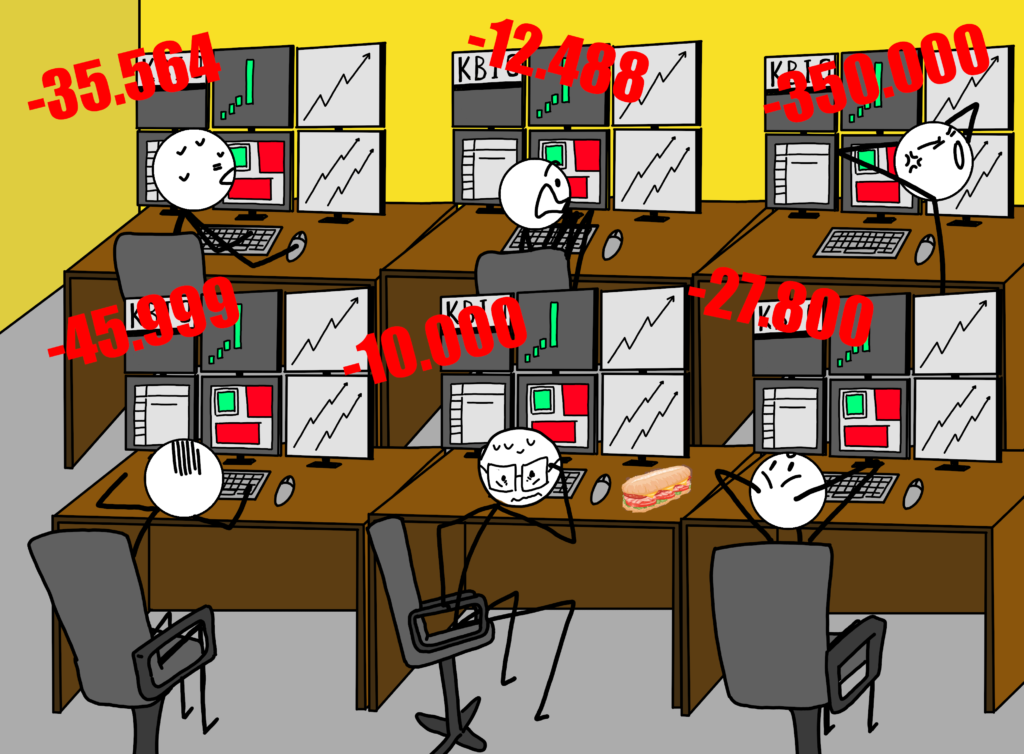
Relative to the massive carnage on the rest of the desk, Clockwork considers himself lucky to escape with what amounted as a slap on the wrist. He saw the initial afterhours burst and covered his small position off pure reflex for a $10,000 loss. Some sat in pure disbelief as their losses grew exponentially13(another top trader on the desk lost $350,000 on this day). This experience underscored a crucial lesson for him in the unpredictable realm of low-float stocks: even the most “obvious” short positions can result in the most severe squeezes.
Market Volatility Plays
Equity traders don’t usually trade indices on a daily basis–that’s more for the futures traders. They only trade indices and market ETFs on an episodic basis–which entails only attempting to trade periods of exceptional volatility. Let’s use the Volatility Index or VIX as a simple measure of market volatility: A 30 VIX market might happen a few times a year. A 50 VIX market happens a few times every decade. They represent peak market chaos and investor capitulation.
At WTG, it’s basically a rite of passage to bring out the big guns on market capitulation days14(colloquially called “flash crashes”, although not referring to THE flash crash in 2010). It’s when their top guys make 7 or 8 figures in a single day. The pattern is simple: the market completely implodes with 99th-percentile downside range and then there’s a massive bounce. There’s usually insane price dislocation on individual stocks for those fast enough to identify them.
On the Monday of August 24th 2015…
… Clockwork witnesses his first 50 VIX market as a professional trader. The SPY plummets 6% at the day’s start, capping off a 12% fall over the preceding three days, with no clear cause for the drop. Traders at WTG were calling this another Black Monday and at the open, they began aggressively buying into the sharpest declining stocks, a move quickly mirrored by many of the younger traders at MBC. Traders were just shouting out any ticker name that had a huge gap down and Clockwork found himself blindly tapping the buy button on names he’d never before traded. But he didn’t go as heavy as other traders on the desk because of one uncomfortable thought…
What happens if we go down more? Am I buying even more or am I getting out?
But that dilemma never came to fruition, as the SPY would plant its morning low within the first 5 minutes of the bell and then bounce higher all day. Those brave enough to buy the weakness were handsomely rewarded. Clockwork made $69,600 that day–tallying his personal best daily gain. Nonetheless, he felt the sting of envy. He saw peers with comparable experience at the trading desk raking in profits in the mid-six figures, dwarfing his considerably smaller profits. Adding to his chagrin, he discovered that a rookie out in Austin, only a year into the profession, had amassed over $500,000 that same day.
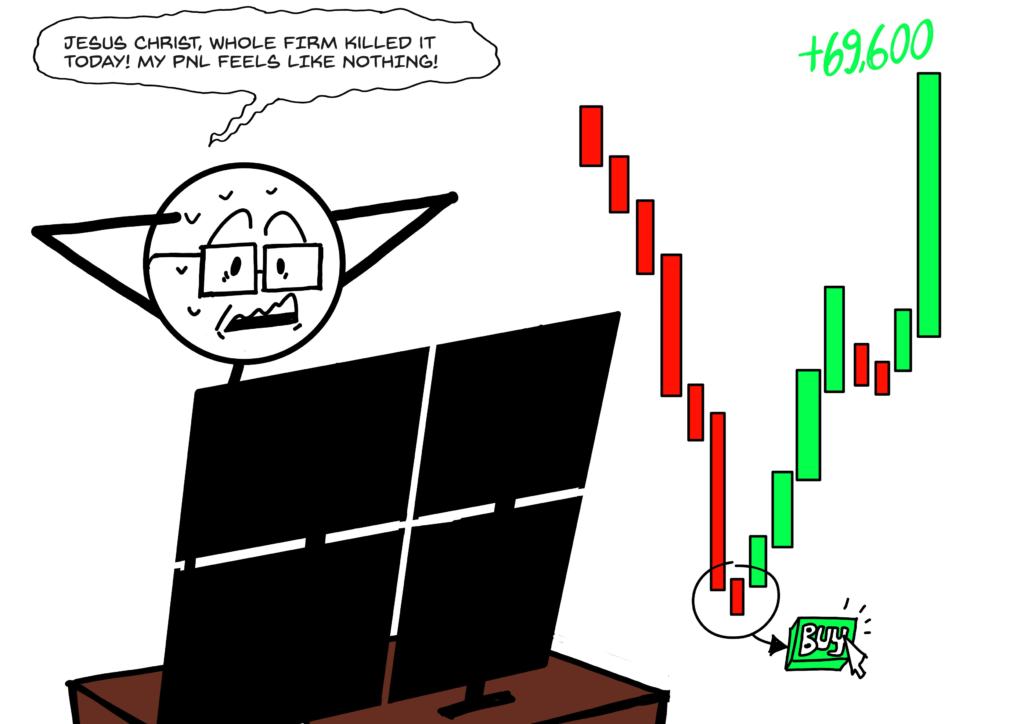
The challenge with engaging in a 50-VIX market lies in their rare occurrence. While they present significant opportunities, their infrequency makes it difficult for any trader to build conviction from either experience or a high sample size of data. In these fleeting instances, traders are faced with a decision: discover a moment of truth15(read: grab your balls) and deploy larger risk or hesitate and later lament not fully capitalizing.
For Clockwork, it’s mostly lamenting. I guess there’s always next time…
Portrait of a Trader as a Team Leader
In 2015, Victor and Avery decide to change up the composition of the MBC trading desk by dividing it into sub-groups for tighter communication and closer relationships.
Ok let’s have our top traders be the focal points on our desk. Let’s have their mentees right next to them and create roles for new traders to help the top guys while they learn the ropes themselves. Which traders do we want to lead?
Clockwork gets appointed as one of the first team leaders. He is told to foster a culture of idea exchange and assign team-oriented roles that suit each of his traders’ respective strengths. The new traders could complement Clockwork in the areas where he did not invest as many skill points.

In theory, MBC’s management assigned new team members based on a blend of criteria: compatibility in trading approach, specific personality traits, and friendships formed during their initial three months as a trainee. However, for Clockwork, the selection process appeared a bit uninspired—his team seemed to be assembled based solely on the fact that everyone is Asian. Not that he minds, but he does notice it. Initially, it’s him alongside a tight-knit group of three.
There was Tian, the technician and a former RiteAid pharmacist. He was in charge of technical stuff–identifying major breakout candidates for swing trades and tracking the implied volatility and open interest levels on relevant option chains. Among the trainees, he had the most bravado, holding no qualms when it came to trading size.
There was Lu, the analyst fresh out of college. Lu’s main role was to go through the news and create a morning watchlist of stocks in play. He would rip through FDA, Fed, and IPO calendars to find event-driven moves. He’d also volunteer to wake up at 4am to grab stock locates for the team, a key role in the low float strategy.
There was Sun, the tinkerer. Sun was charged with optimizing the main trading software, Pr0Trade, and developing new stock filters. He built Clockwork a scanner to quickly find the fastest rising stocks in the pre-market. Additionally, he had a more essential duty: guiding the recently single Clockwork into the bustling NYC dating scene.
Yet, for each of them, their specific duties within the team took a backseat to their ultimate ambition: become a CPT and make their living from trading. They didn’t get paid anything for their secondary work and so they needed to make money from the market. Consequently, Clockwork assumed an major responsibility—to mentor his team towards becoming proficient traders. He quickly discovered that coaching was a more challenging endeavor than trading itself.
Watching his mentees struggle impacted Clockwork more deeply than any personal financial setback. Their camaraderie extended beyond the trading floor—they would bond over Korean BBQ, hold regular monthly meetings to set goals, and engage in after-hours Q&A sessions to go over the daily action. He found himself feeling deeply invested in their success–he hoped to succeed with his closest trading friends, the same way he did with Pete, Tommy, Mesut, and Colsen, all those years ago at the beginning.
One member of the team, Lu, had an issue pulling the trigger on trades. He couldn’t differentiate between the A+ setups and the rest, finding himself getting lost in the fog of the market.

At his most desperate, he’d just tell Lu: just copy my trade! I am shorting a million dollars worth on this bid, just join in! And Lu would either tentatively short 100 shares or miss the trade entirely. And if he made anything on the trade, he’d then lose that money in the next 10 shit trades. Ultimately, after a few unprofitable years, Lu chose to move on, marking the close of his time with team Clockwork. Unfortunately, it doesn’t always work out they way we want it to. It just doesn’t click for some reason.
It’s happening all over again… friends coming and going.
Portrait of a Trader Using the Old Bag of Tricks
You never know when the old skills are needed again.
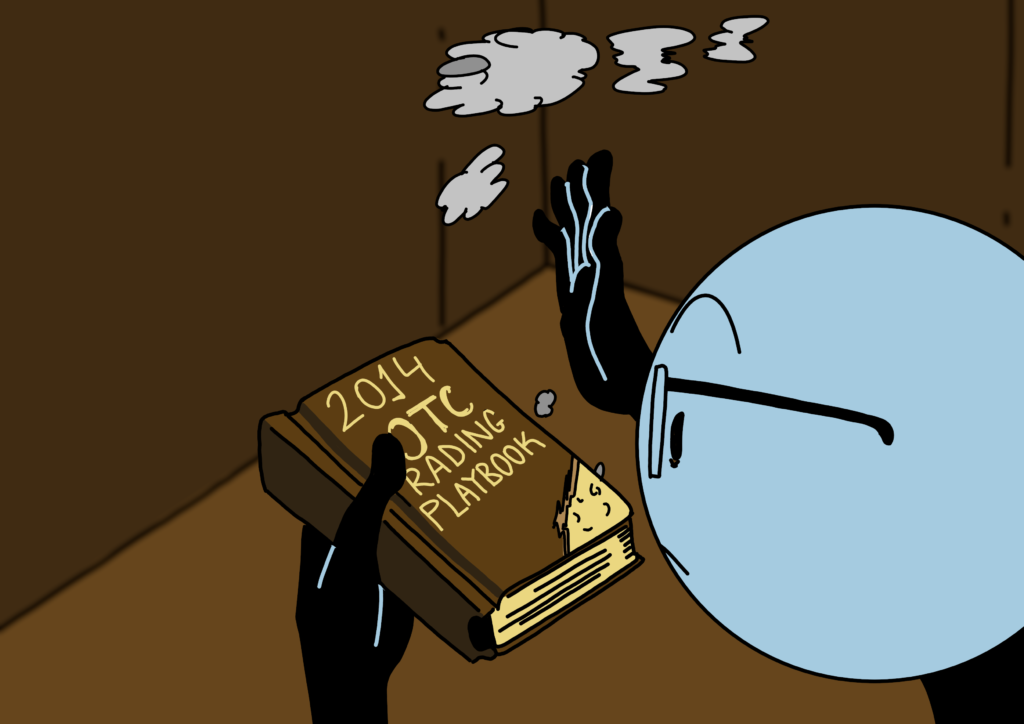
In late 2017, crypto had come roaring back after a 3-year bear market. Equity traders without capital in the crypto markets needed to find proxies to participate in this new wave of speculation. They either had to trade the first wave of new crypto miners (RIOT, MARA, LFIN)16many of these had questionable business practices and operations, as expected or trade a stock called GBTC–Grayscale Bitcoin Trust. GBTC owned bitcoin for the investor, giving them exposure without direct ownership. It was essentially the only bitcoin ETF but without official SEC approval, it could only trade as a close-ended fund on the OTC Markets–yep, our good ol’ stomping grounds from 2013-2014.
In an efficient market, there shouldn’t be a reason to trade GBTC over bitcoin. It will follow bitcoin 1 to 1 and given that plus the fact that bitcoin trades 24/7 while GBTC only trades during 9:30-4pm EST market hours, there shouldn’t be any reason to actively trade it. You’re just getting all the downsides… or so you’d think.
When I began closely monitoring GBTC on the tape, it became evident that there was extra momentum to its daily movements. For instance, if bitcoin appreciated by 3% since GBTC’s last close, GBTC would show a similar 3% increase on pre-market quotes the following day. Ok, straight forward enough right? But then the market would open and something familiar would happen.

The stock would open with a tight spread and then volume pours in the first 5 minutes. Buyers would soak all the prints on the bid and then the offer loosens up and the stock would trade significantly higher, often times another 5% higher while bitcoin itself remained at the same price. I would buy 100 shares on this action and I’d often catch a clean 25-50 points–it’s basically the old opening drive play I learned from observing FNMA but it was playing out on a more nominally expensive stock with a thinner tape.
Because of this extra “in-flow”, GBTC would trade with a hefty premium over its underlying Net Asset Value (NAV). Maybe it was day traders like us amplifying the premium with our parasitic order flow. Maybe it was equity investors eager to add GBTC to their 401k without reading the fine print about what they’re paying for. Or maybe we just chalk it up to OTC black magic. We’ll never know.
So I ping Clockwork–you ought to check this out.
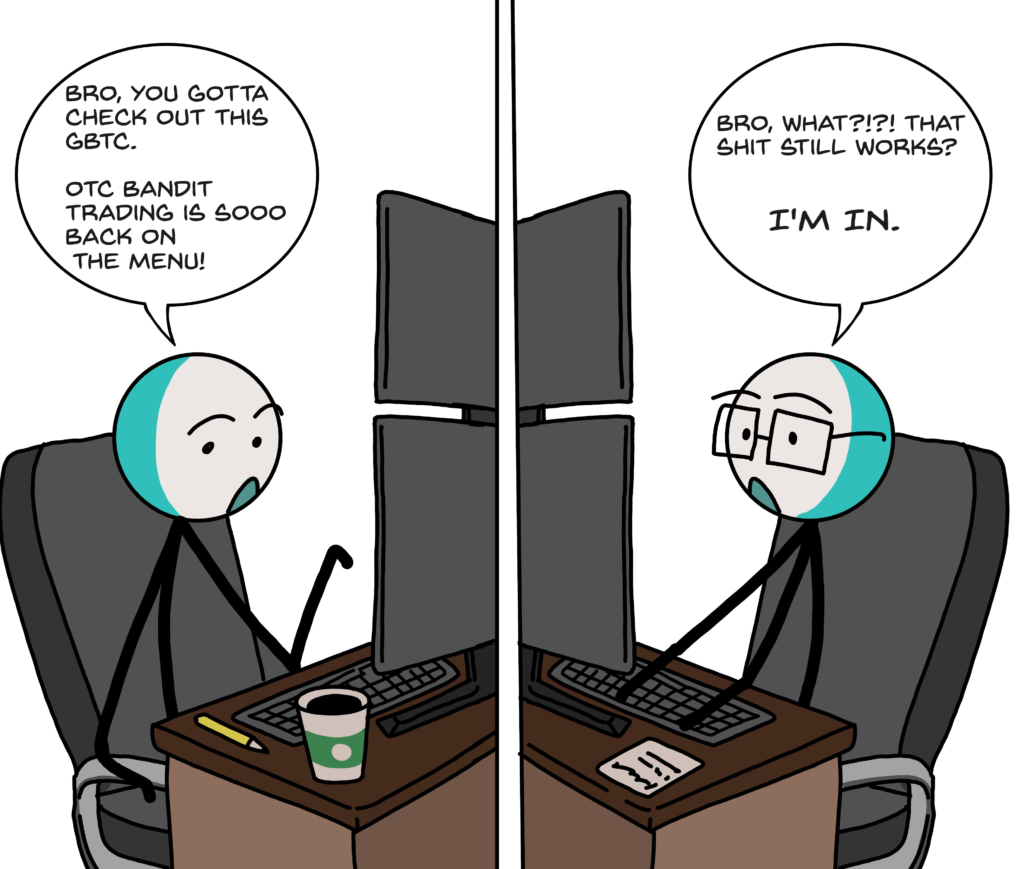
So for a good few weeks, we blitz out on GBTC, using the old OTC playbook that initially made me us Consistent Profitable Traders. That’s great.
But as both bitcoin and GBTC continued to make new highs, Clockwork and the MBC Securities desk did not seem content with these easy money scalps. As the premium to NAV increased to astounding levels over 100%, traders began to anticipate a big mean reversion move–a scenario where bitcoin would undergo a 10-20% correction, potentially triggering a massive 30-50% downturn in GBTC as well.
I personally did not care for this.17This wasn’t to say I didn’t make money shorting GBTC, but they were tape-driven scalps with 100-200 shares where I didn’t try to force the issue. Scalping GBTC was not a highly scalable situation because the tape had low liquidity and depth. Why turn down easy money to force a position trade with a considerably larger amount of risk? If you tried to short 500-1000 shares, you could easily get stuck trying to stop out18(reminder: OTC trading mechanics are not instant get-in/get-out like NYSE/NASDAQ stocks) and the slippage would crush the trade’s expected risk-reward.
So one day in late November, bitcoin crosses $10,000 for the first time ever in its short history. GBTC is trading at a whopping $1800. At this point, our trading outlook starts to differ. I want to stay with the easy money strategy while Clockwork wants to short 1000 shares and make six figures on a position play. The 2013-2015 version of Clockwork definitely does NOT do this.
Bitcoin starts to rotate around $10,000, slowing down a bit but not violently correcting either, which made the GBTC downside potential appear somewhat ambiguous. GBTC’s tape appears to have its own thing going on. It ebbs and flows and as we’re trading it… some early sellers emerge to break the opening range. Clockwork plunges into 700 shares short–a $3 million position.
It washes out 100 points but there’s a moment where this initial dip gets soaked–a clear buy signal for scalpers. He covers some, not all. Clockwork’s profits swing from a $80,000 to $40,000–representing a 50% downturn. GBTC holds up for a little bit and looks primed for a new high.
Clockwork: Fuck. I might have to stop out for a loss.
There’s a pang of regret, stemming from his old scalper’s mindset… why didn’t I just follow Pete and scalp it? I’m a scalper, that’s what I do–I take quick gains. I don’t let it reverse all the way against me.
But there’s no new high. The price rolls over in the late afternoon–PAY DAY!

I asked Clockwork, what do you consider your breakthrough moment, going from a 6-figure scalper to a 7-figure trader? He points to this GBTC trade of $165,046 in profit because he feels this is the first time he truly committed for a bigger move rather than just accepting a smaller gain.
Indeed, bitcoin did not reach its pinnacle at $10,000 nor did GBTC top out at $1800 during the 2017 crypto bull market. In fact, they nearly doubled from these prices. What happened then?
MBC Securities vs. GBTC Round II
It’s December 19th and bitcoin is near $20,000. GBTC now trades at an outrageous $3000.
Clockwork and I have each surpassed $300,000 this year solely on GBTC—it stands unparalleled as the most profitable stock in our trading history.
Naturally, it’s time to get a little greedy. Everyone on the MBC desk has that November 29th trading day squarely on their minds, thinking that now that GBTC has doubled that price, that suggests that the inevitable mean reversion move will be even greater than before. Many felt entitled to large gains, thinking it would be the easiest slam dunk short ever.
So GBTC opens at $3200 and there’s a seller stack right off the open. Time to get short.

It’s not easy to fill size so most traders only print 100-200 shares. The stock nose dives 20% off the open to $2600. That’s already a big move! Clockwork is up a pain-free $35,000 but for him, it feels like absolutely nothing considering his prior expectations.
I piece out and cover starting from $2800 and below. In my opinion, the easy money is over and I’m happy to take what I can get. He doesn’t feel the same way… and a certain emotion takes ahold of him that I rarely see: Greed.
“I’m going to add into all pops… I don’t care, I need to make more on this trade.”
So GBTC bottoms at $2600 and there’s this a big snapback bounce. At $3000, everyone on the MBC desk considers it a gift of a price and they lean into the short. Wow, who are these idiot buyers who can’t tell that this GBTC is absolutely cooked? Let’s sell these fools all they can eat.
It rips through $3000 with ease. Within minutes, it’s $3200 and there is no market depth in sight on the sell side. All those heavy sellers from the opening 10 mintues–where did they go??? Now that “this price is a gift” mentality has completely shifted in an instant to “what the fuck is going on with this thing?” Bitcoin isn’t even rallying back to highs yet–GBTC has completely decoupled and moves on its own accord. It makes zero sense.
For a good two hours, MBC traders, deep in the red, are praying for sellers to return. Many are experiencing major cognitive dissonance as their effortless morning profits have disppeared into this nasty reversal move. At this point, the desk is having one of its worst days of the year. What seemed like an incredible opportunity from the morning has unexpectedly turned into a nightmare.
Clockwork has been rapidly updating me in real-time about his calamity of a trade. Usually he’s the more chill trader between the two of us, but today, his emotions are palpable even through the placid UI of instant message.

….and once GBTC trades over the morning highs, everyone is jamming in their cover orders, fighting for a tiny amount of shares and running each other over, like a thirsty herd of cattle swarming for the last bucket of water. Clockwork tells me he’s trying to market out and that he’s barely getting any fills as his loss grows larger.
And after that…nothing but radio silence from him. I didn’t know what was happening. I hope he didn’t blow up.
Apparently, Clockwork and a few others had been summoned away from the trading desk.
Victor: Everyone who’s trading GBTC–mandatory meeting right now.
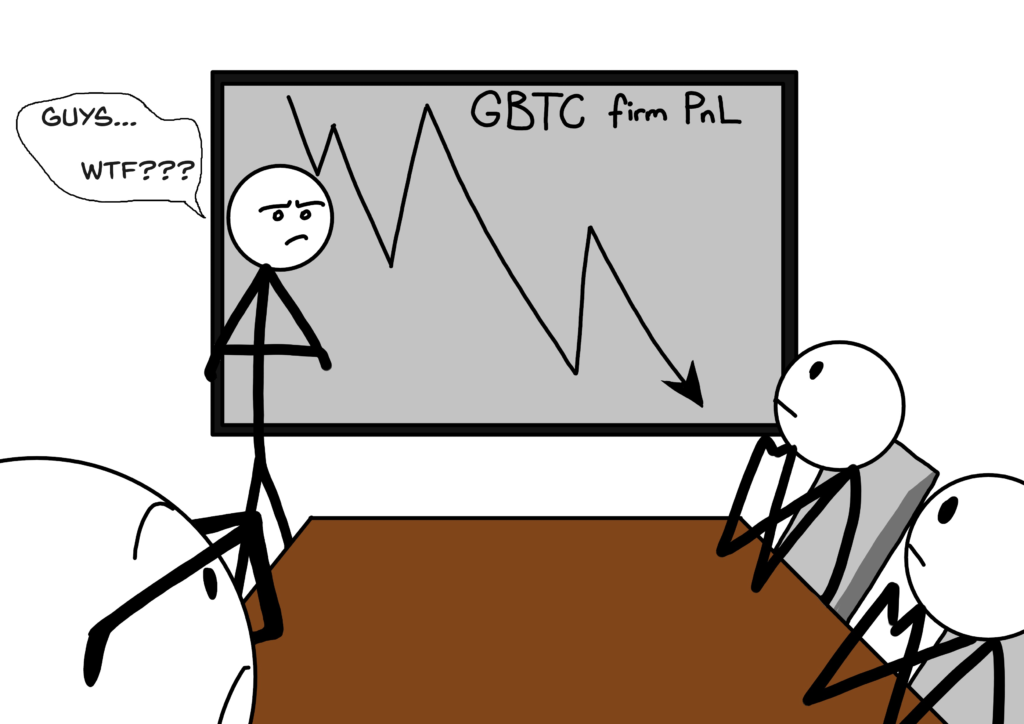
Never before has there been an emergency meeting like this regarding the desk losing a bunch of money on a single stock. The numbers were not ‘blow up the firm’ bad but they wanted to nip this in the bud before it reached that point. I guess they still have bad memories of what happened when one of their traders got carried away on an OTC stock without sufficient oversight.
The last 3 hours of trading had represented one of the worst PnL swings that Victor has observed on the desk in years–everyone up X! the first 20 minutes and now down 4X!!!! hours later as traders slam their keyboards and yell GIMME THE FUCKING FILL! He tries to break it down gently to everyone that there’s been discussion between him and the risk management team in Austin that they need to contain the loss potential on GBTC. The stock is just too wild and it’s too hard to trade it safely with such poor liquidity on the tape. It’s time to be prudent. He warns each trader that their risk is being tightly monitored at this point and that any excessive loss on GBTC will be taken out of their hands.
Victor: I know it’s disappointing but we have to live to fight for another day.
After this, Clockwork opts to leave GBTC alone, feeling his hands are now tied by Victor’s mandate. He ends the day down -$63,071 on the stock and it feels massively upsetting. During the meeting, GBTC reaches a new all time high of $3525…
…and then 3 days later, it would trade as low as $1200. That meeting ended up marking the dead top.
There’s a lesson there and it’s a one that Clockwork would take to heart in his future trades.
New Milestones
The ‘Emergency Meeting’ debacle not withstanding, 2017 still ends triumphantly for Clockwork–he records $2 million in net profits, his most successful year yet.

Seeing him further realize his potential, management decides to commemorate him on surpassing an important PnL milestone. One of Victor’s team building ideas was to create a tier system of achievements for their traders that would prompt a collective firm celebration outing. One of those major tiers was called ‘Blackshirt’ status–given to anyone who netted $2 million in a calendar year. Clockwork would be the second trader to ever reach Blackshirt after his killer month trading GBTC. Witnessing his achievement filled everyone at MBC with joy and celebration–our boy Clockwork, who used to pike out in seconds for $100 gains, finally getting to 7-figure status.
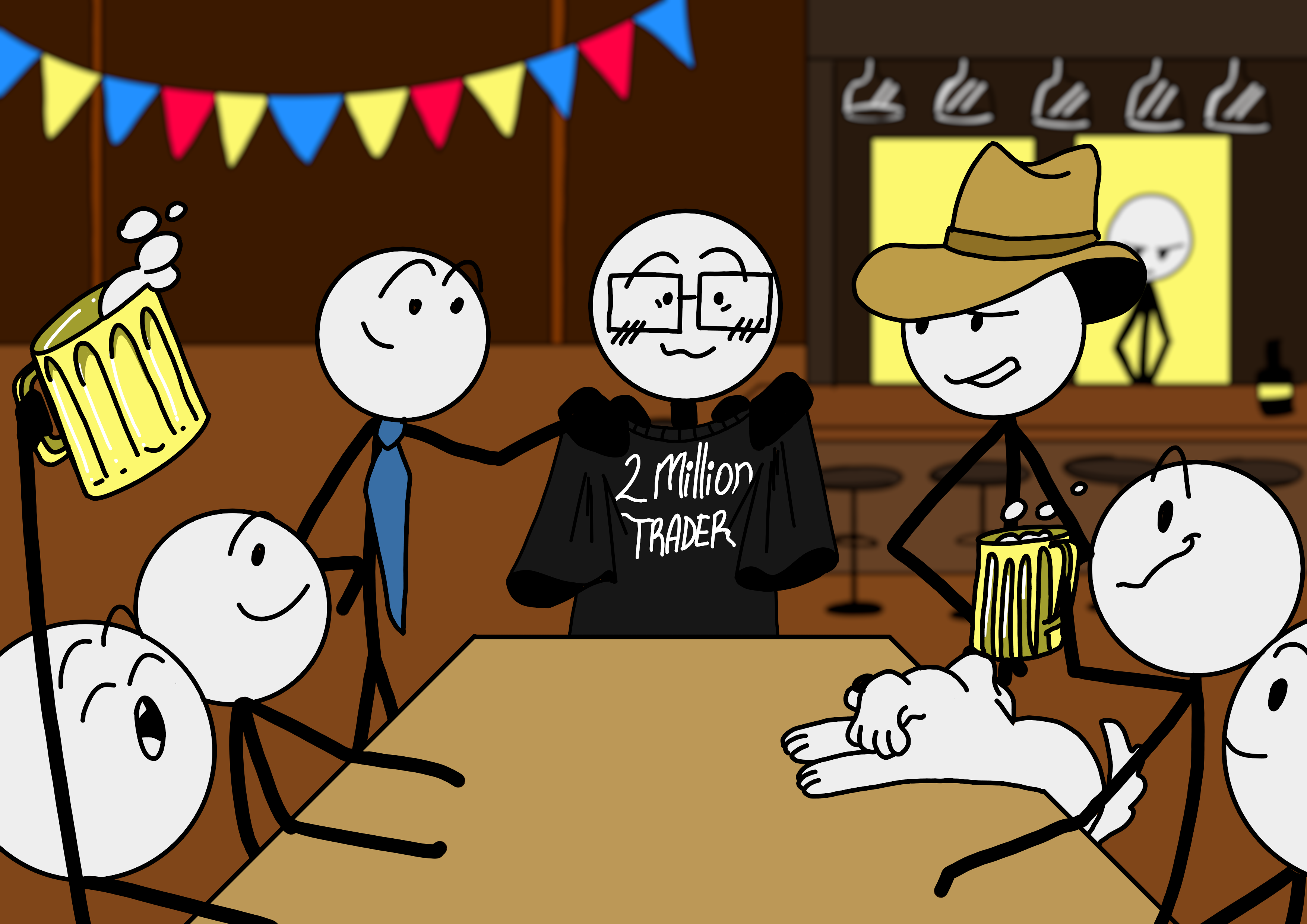
Sizing Up
Management encouraged him to size up and size up, he did. He started to feel bolder on all the other plays–the low floats, market plays, IPOs and options.
The Saga of DryShips (DRYS)
There could be a whole chapter about the shit show that was DRYS–it was basically the meme stock before meme stocks became a thing. DryShips Inc had been a legitimate dry bulk shipping company from 2004 to 2014. Post Great Financial Crisis, the entire dry bulk shipping sector went into terminal decline. Then DRYS CEO George Economou, with a stroke of brilliance, decided… why don’t I just transform my stock into a low float pump and dump instead? So one day, DRYS pumps from the single digits to well over $100 across 2 days. From that point on, it slowly becomes a cargo cult fascination among foolish Junk Stock retail investors. These people would somehow maintain this steadfast belief that one day there would be a massive short squeeze that would cover all their losses. It was peak delusion.
After that one amazing pump, the stock became Economou’s personal ATM–he raises billions via toxic convertible debt and executes eight reverse splits in the span of a year, as investors lost 99.9% of their money during that time. Needless to say, there were many opportunities for Clockwork to short DRYS and ride Economou’s endless wave of toxic paper selling. It was the first time he had ever made over six figures cumulatively on a low float play.
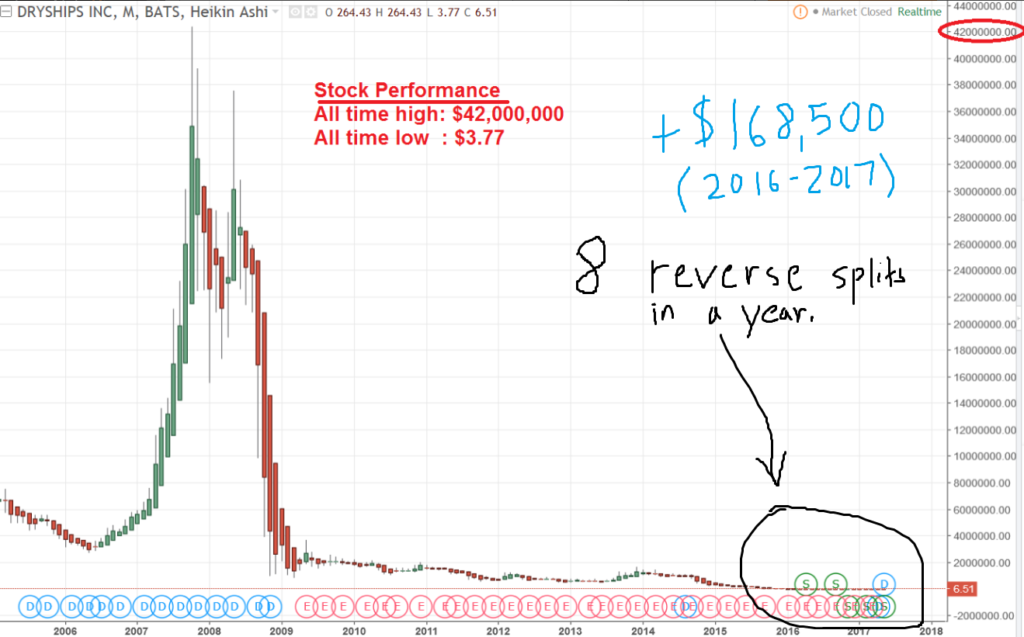
DRYS would end as his largest PnL on a single low float ticker to date.
The Vixmeggedon
Then there was the Feb 6th 2018 market–the second time that Clockwork witnesses the VIX going above 50.
Most of us don’t remember the reason for the broad market’s sharp decline but the chaos that erupted within the volatility ETFs remains unforgettable— an event that the financial press would dub ‘The Vixmeggedon’. The slow grinding bull market that had matriculated since 2011 had popularized a certain brand of “short volatility” strategies. As volatility died out in broad markets and VIX instruments found themselves in long-term terminal decline, traders increasingly started to short volatility to the point where the trade had become overcrowded with amateurs and reckless fools. They thought it would be easy money to hold poorly-understood short-vol ETFs in their long-term portfolios and add on every dip. As long as the market always rebounds, which it always does, they would fine… or so they thought.
On February 5th, the VIX experienced an unprecedented surge of 115% in a single day–the highest since the 2008 Great Financial Crisis. At 4:30pm after the bell, every stock trader on the Earth turned their attention to one single obscure VIX-driven ETF–VelocityShares Daily Inverse VIX Short Term or ‘XIV’.19I didn’t know of this subreddit until after the blowup but I was shocked to discover a sizable population of non-pro traders dedicated to buying XIV and none of them forsaw what would happen. Regular-ass people lost MILLIONS
XIV, which opened the day at $109, starts tumbling with no bids in sight. First $80. 10 minutes later $50. Twenty minutes later $30. Then a low of $10, with no bounce whatsoever. It turns out that XIV’s prospectus included a clause that if its indicative value were to drop by 80% or more in a single day, it would trigger an acceleration event, leading to the redemption of the ETF at a price equal to ZERO. A short squeeze in VIX futures afterhours triggered this obscure clause. One of Clockwork’s more diligent colleagues started spreading the info that XIV was basically a guaranteed 0. So Clockwork just hit the bids without thinking. He added more as it went lower.

The next day, Clockwork knew he had to stay hungry. It wasn’t enough to just bag an unexpected 6-figure gain on a ticker he had previously never heard of before. He still retained the memory of August 2015 of when he was too cautious while the rest of the firm dove in head first with massive risk and reaped colossal gains. He had his eyes on the VXX, which itself rocketed up 400% over 3 days. It became an attractive short candidate to align with an inevitable market bounce. The massive surge in these instruments were caused by a huge blowout stemming from all the short-vol traders and he knew these levels could not be sustained for long. An extreme wave of price insensitive buyers cannot last. He also knew that in event of a large broad market gap down, he could deploy the previous 2015 strategy of snapping up individual names with large price dislocation. Feb 6th 2018 was a day to bring the big guns or forever lament not doing so.
The market opened with a large gap down and just like August 2015, it quickly shot up in the first ten minutes to erase most of the losses. Correspondingly, the VXX saw a sharp decline at the open.

Clockwork swiftly hit everything VIX-related on sight–he hit TVIX, VXX, SVXY, UVXY20(is it neccesary to trade every single VXX ETF like this? No it’s not, trading just one would suffice. It’s just what he did and I won’t try to explain it). If it had a V and an X in the ticker, he hit it short. He had a ball of a day, most of it within the first 30 minutes of the open, resulting in another career best daily PnL.

The chaos of Feb 2018 kicked off another prosperous year for the newly minted Blackshirt trader. By month’s end, he crossed $1,000,000 in PnL YTD. This is a trader experiencing exponential growth in his eighth year of professional trading. Pretty neat. Making a million dollars in a year is cool.

You know what would be even more cool? Making a million dollars in a single day.

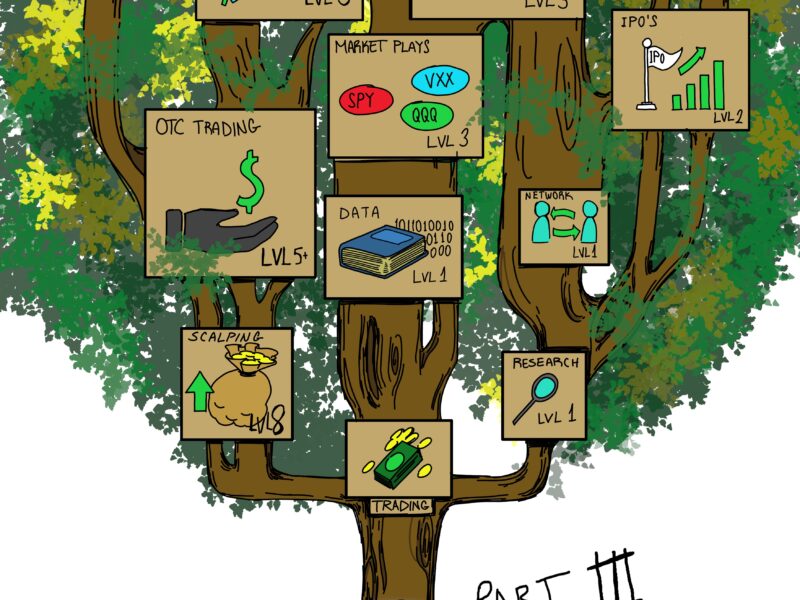


Baller.
Insane stuff. If I wasn’t a born piker , I’d be right there with you.
On reflection, I think you get paid to handle the stress and uncertainty as much as anything. Few can do it .
Latest craze are junk trading 100X the float . 500% borrow rates. Chinese money laundry stocks.
Talk about those ?
Sorta did in my HKD breakdown post. Personally trying to never trade those again…
I am freaking in love with your blog! It is a treasure trove for an aspiring trader.
Please, do keep the posts coming 🙂
Thanks Pete, Great post. I’ve followed MBC for a long time. GMAN days. Even applied and was offered to join, but didn’t have the balls to move cross country then. Things be different now.